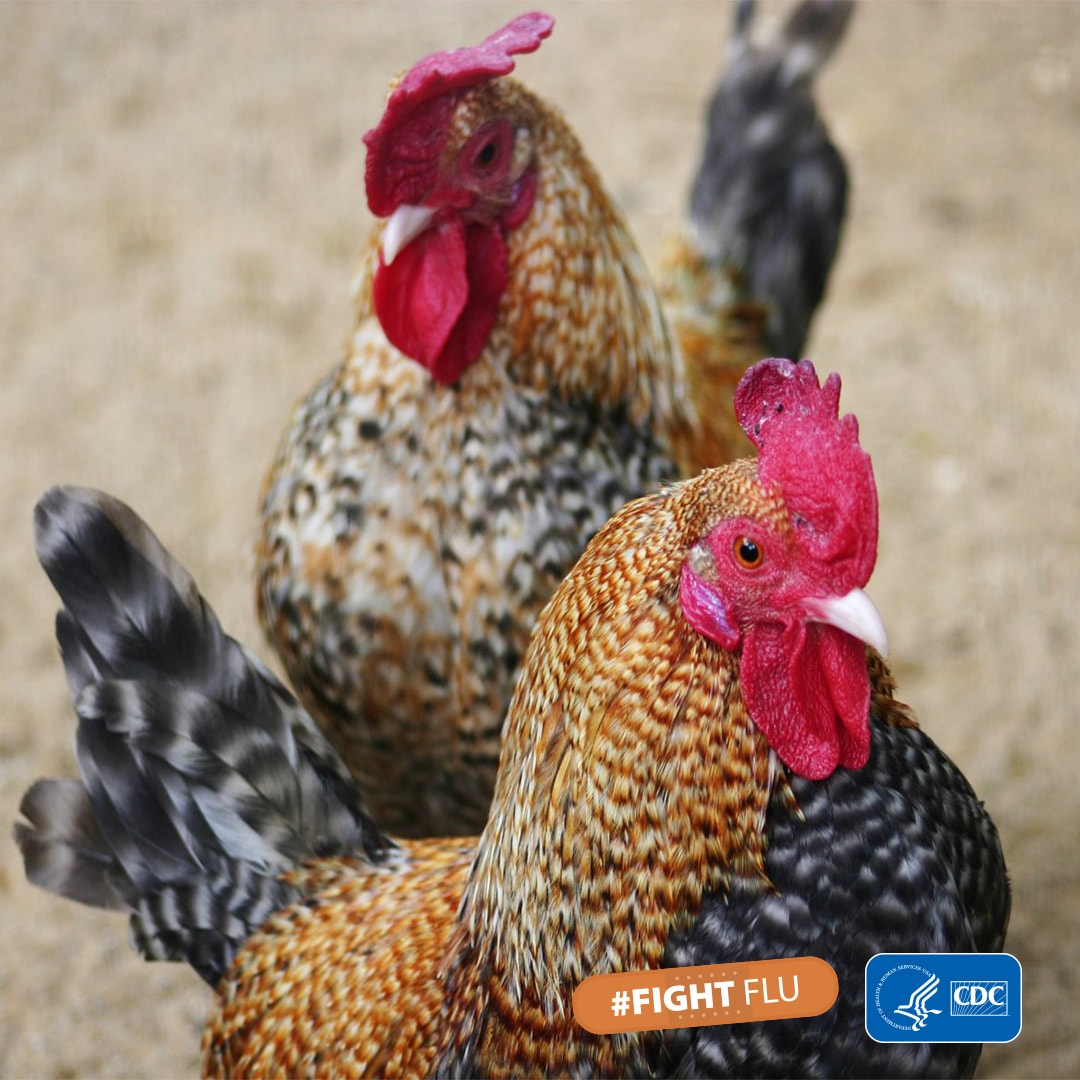Purpose
CDC’s avian influenza (bird flu) social media toolkit is available to assist partners in communicating about bird flu prevention. This digital toolkit includes sample social media copy and associated graphics available for download.
People with exposure to infected or potentially infected cows
Twitter Sample Messages – English
Wondering how #H5N1 bird flu is spreading in dairy cows? This graphic illustrates what is currently known about how spread is happening. Find out more about the current H5N1 bird flu situation: H5 Bird Flu: Current Situation
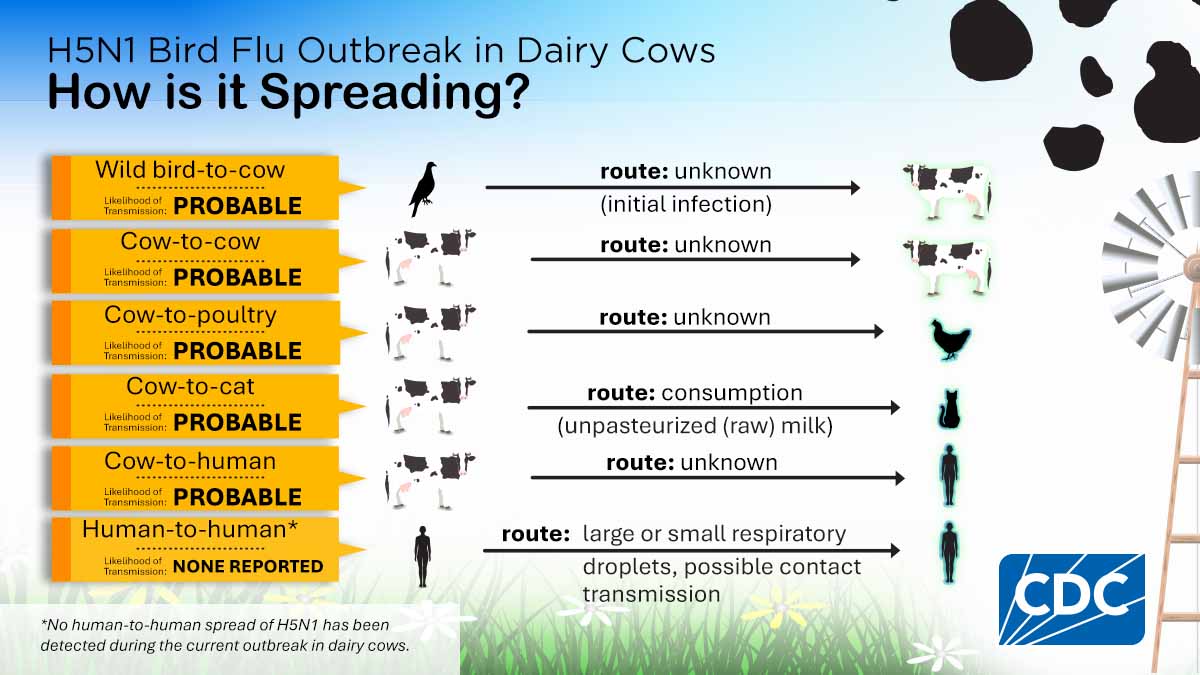
H5N1 bird flu is spreading in some farm animals like poultry and cows. Though rare, it can infect people.
If you are around poultry, dairy cows or raw, unpasteurized milk, seek medical care if you get symptoms of bird flu:
- Fever
- Cough
- Sore Throat
- Muscle Aches
- Shortness of Breath
- Eye Redness
Find out more about the signs of bird flu at https://bit.ly/3R7bYs2
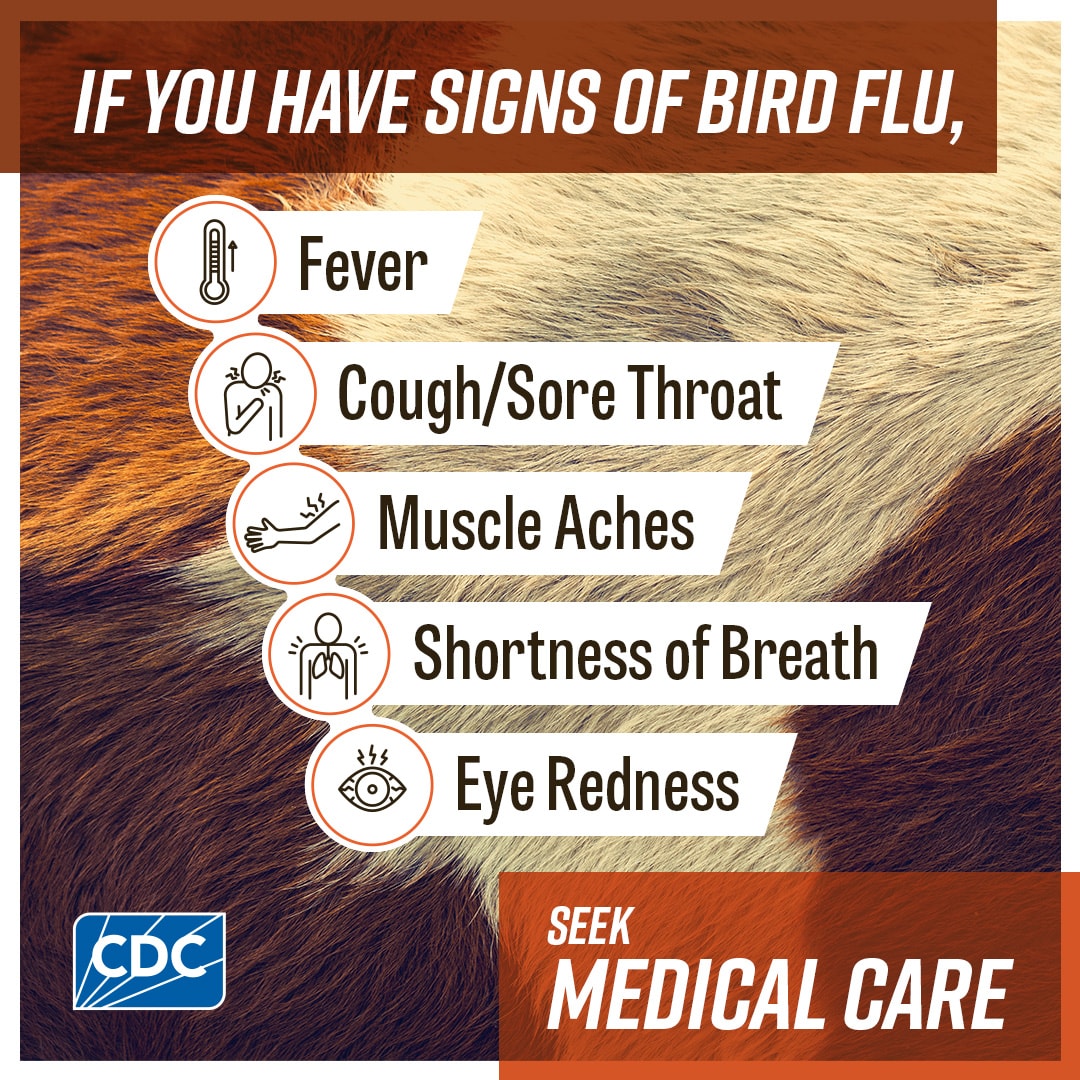
#H5N1 #birdflu is spreading in some farm animals like poultry and cows. Though rare, bird flu can infect people who are around these animals.
Use protective gear when working with poultry, dairy cows or other animals that could be infected:
- Coveralls
- NIOSH® Approved respirator
- Goggles or eye protection
- Head cover
- Boots
- Gloves
Learn the steps to stay safe at the link:https://bit.ly/3X3eIu7
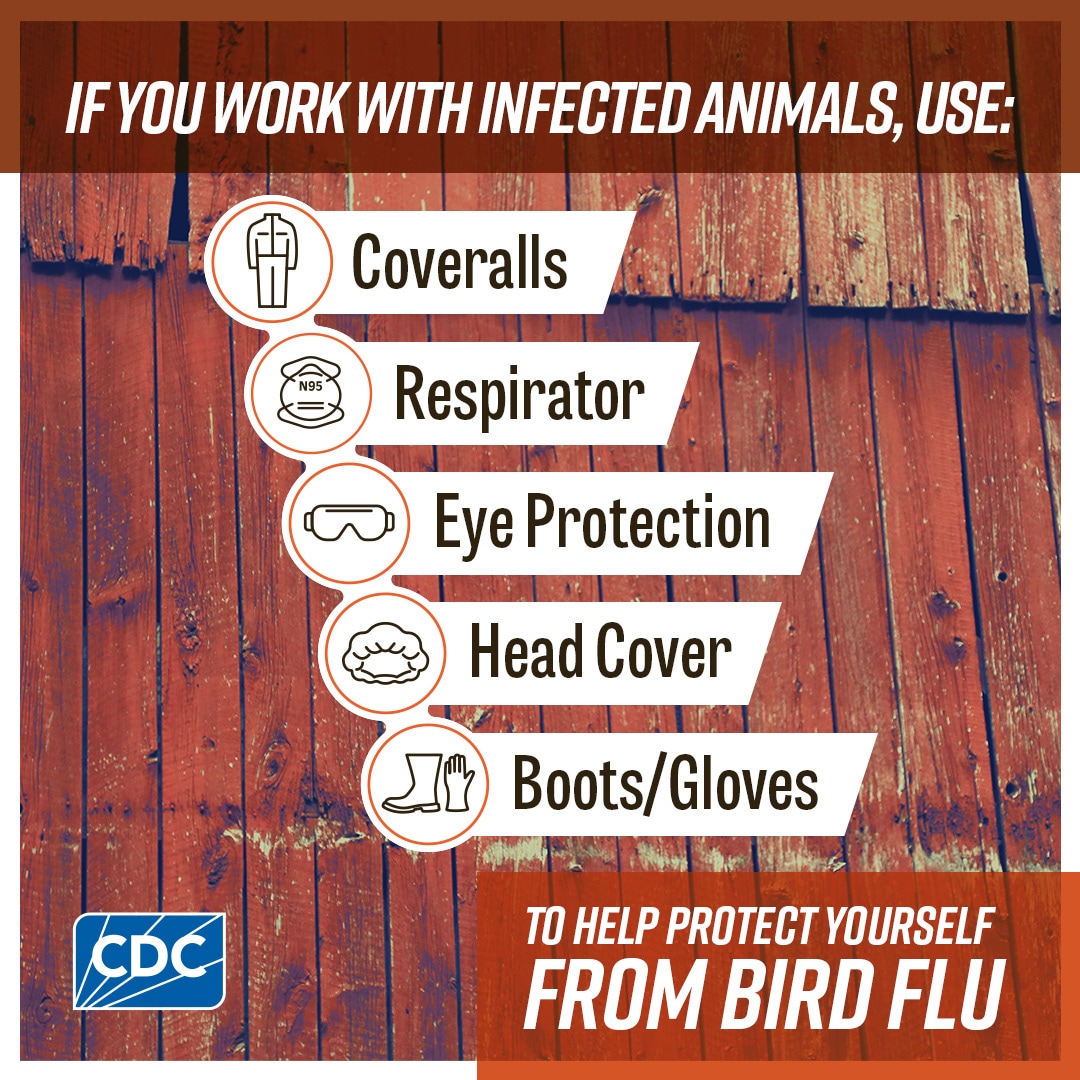
Twitter Sample Message – Spanish
La influenza aviar H5N1 se está propagando en animales como las aves de corral y las vacas, y puede infectar a las personas.
Busca atención médica si tienes síntomas de influenza aviar:
- Fiebre
- Tos
- Dolor de garganta
- Dolores musculares
- Dificultad para respirar
- Enrojecimiento de los ojos
Ve los signos de la influenza aviar en https://bit.ly/3LhZ8nH
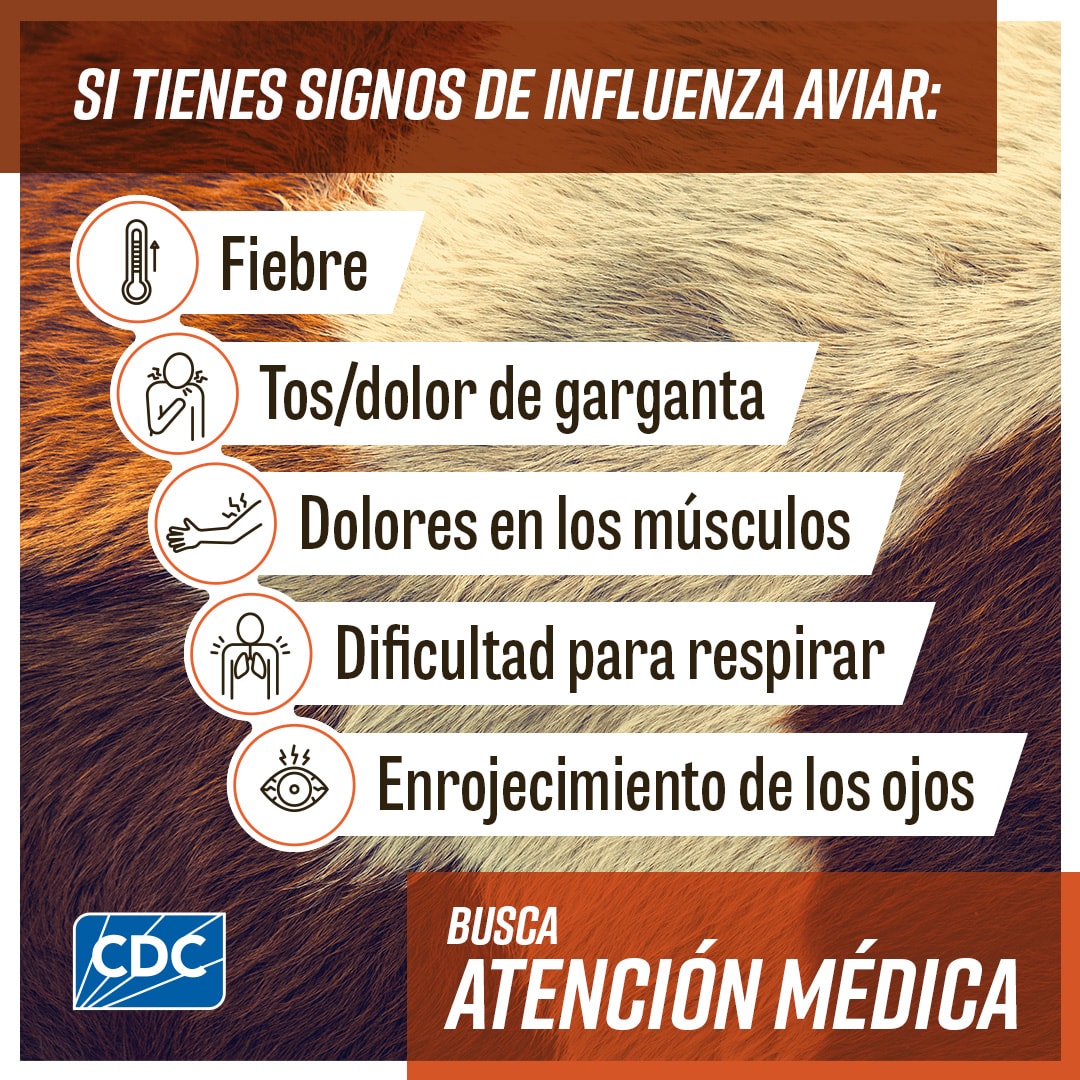
La influenza aviar H5N1 se está propagando en animales como las aves de corral y las vacas. La influenza aviar puede infectar a las personas cerca de ellos.
Usa protección cerca de animales que podrían estar infectados:
- Overoles
- Respirador aprobado por NIOSH®
- Gafas o protección para ojos
- Cubierta para cabeza
- Botas
- Guantes
Ve cómo reducir tu riesgo: https://bit.ly/4cAhJH6
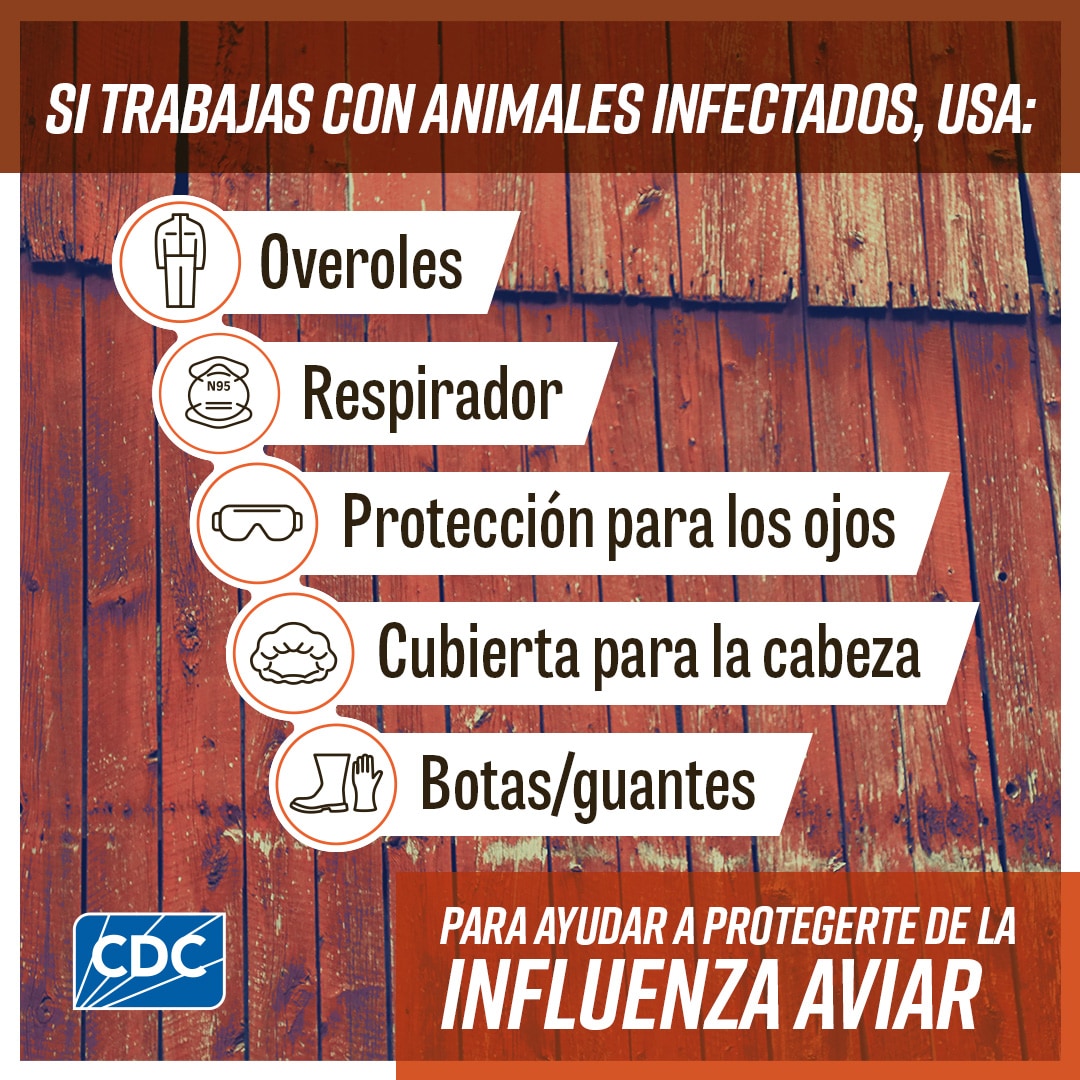
Facebook Sample Message – English
If you work with dairy cows or other animals that could be infected with H5N1 bird flu, find out how to reduce your risk of infection. CDC has information for farm workers exposed to H5N1 bird flu in dairy cows or other animals. https://www.cdc.gov/bird-flu/prevention/farm-workers.html
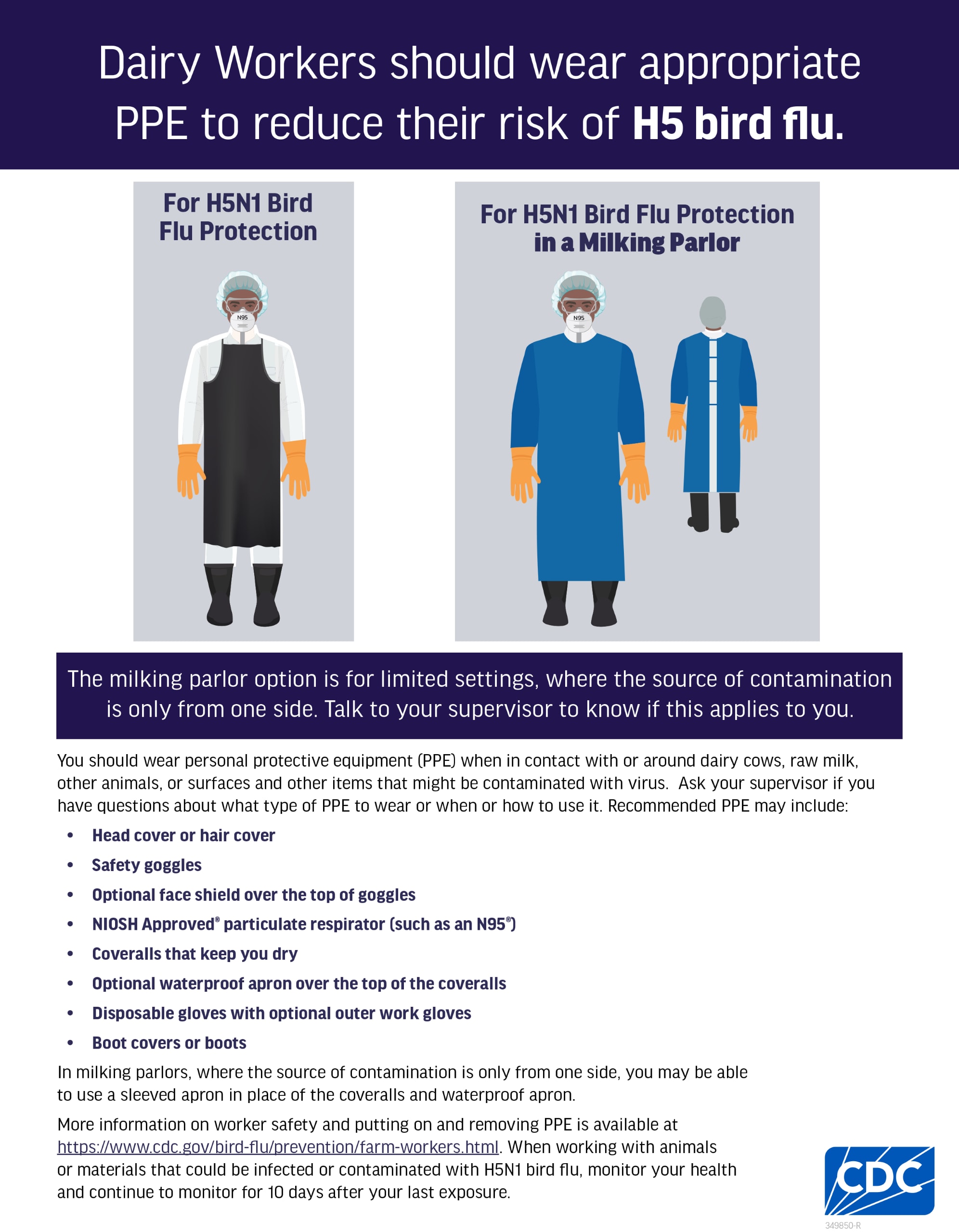
H5N1 bird flu is spreading in poultry and cows. It's rare, but people can become infected too. Be careful working with animals that could be infected. Find out what precautions you can take to work safely around animals at https://bit.ly/3R7bYs2
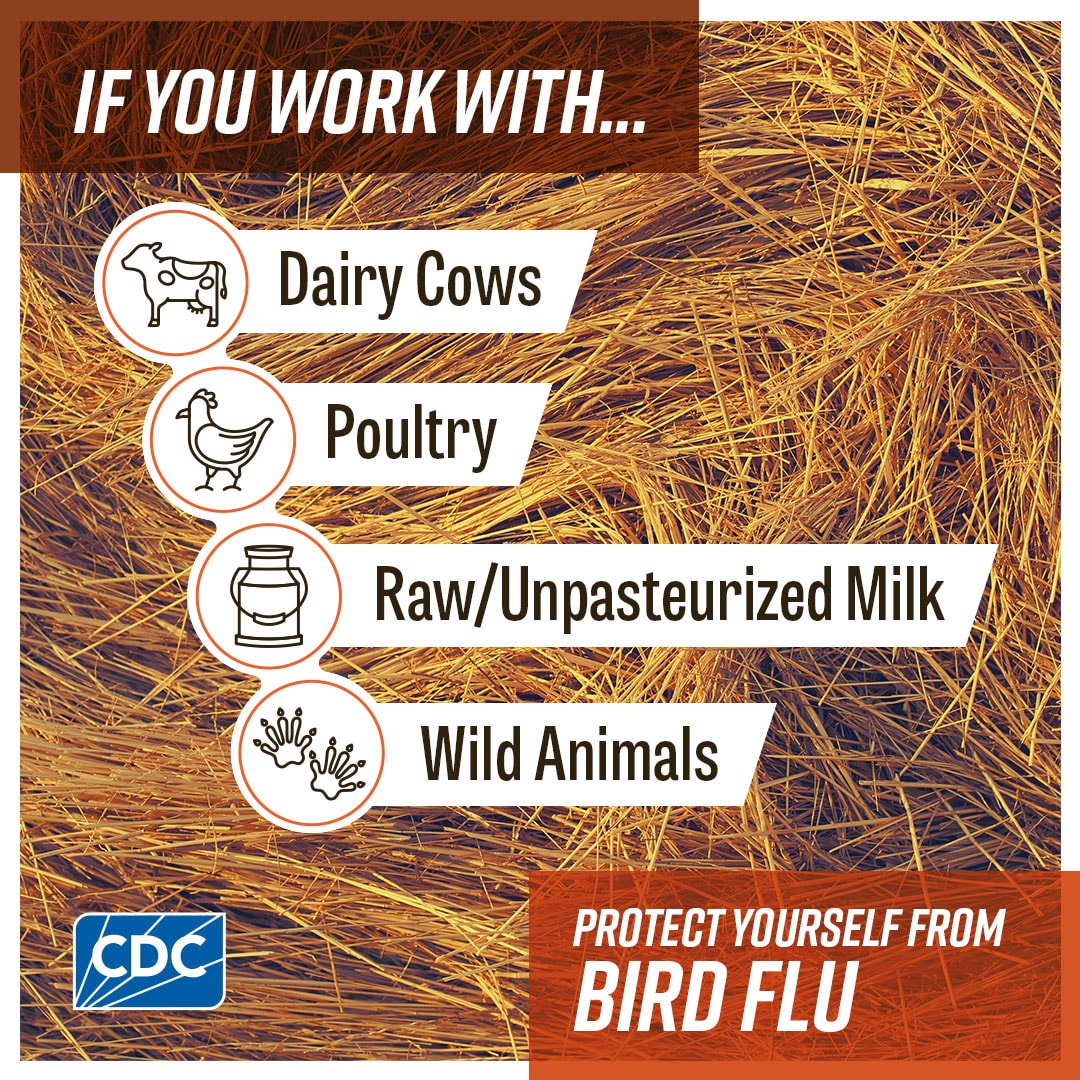
Facebook Sample Message – Spanish
Si trabajan con vacas lecheras u otros animales que podrían tener la #InfluenzaAviar H5N1, tomen medidas para protegerse del riesgo de infectarse.
Los CDC tienen información para trabajadores de granja expuestos al H5N1 en vacas lecheras u otros animales.
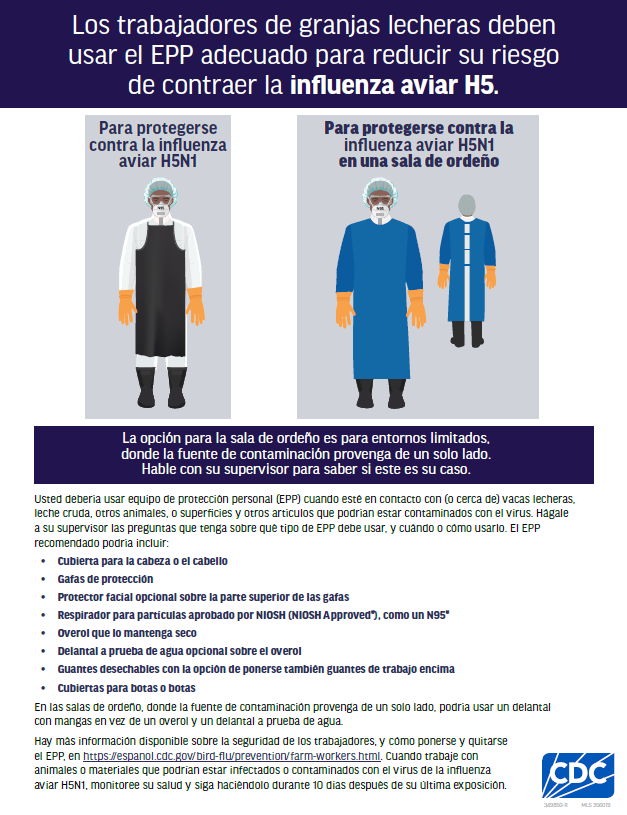
La influenza aviar está propagándose en aves de corral y vacas. Las personas también pueden infectarse. Cuídate al trabajar con animales que podrían estar infectados. Toma estas precauciones al trabajar cerca de animales: https://bit.ly/4cAhJH6
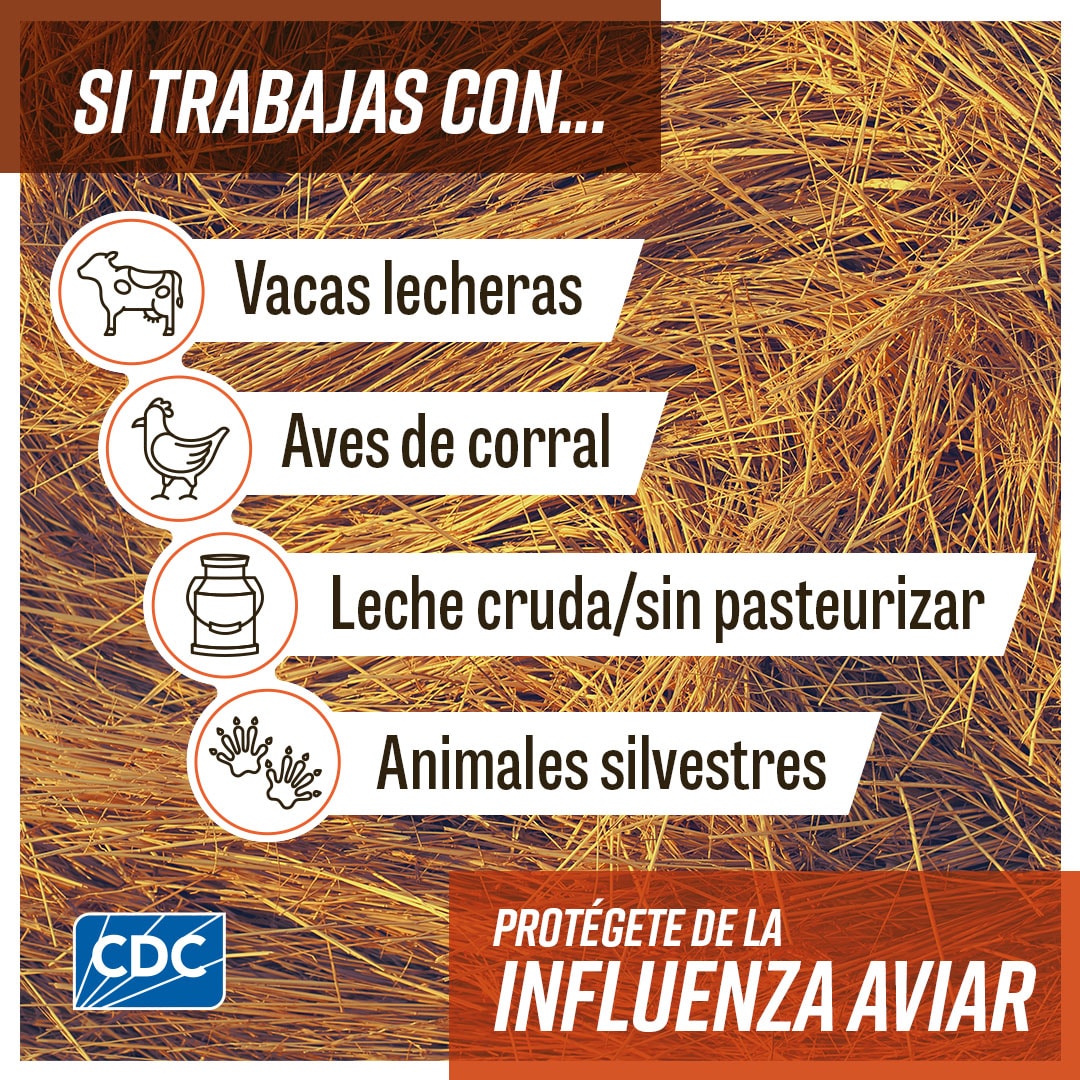
Instagram Sample Message – English
Wondering how #H5N1 bird flu is spreading in dairy cows? While the current risk to most people from H5N1 bird flu is low, people who have contact with infected or potentially infected animals are at higher risk and should take actions to protect themselves. Link in bio to stay up to date on the current H5N1 bird flu situation.
#PublicHealth #BirdFlu #H5N1
Link: https://www.cdc.gov/bird-flu/spotlights/bird-flu-update-052424.html
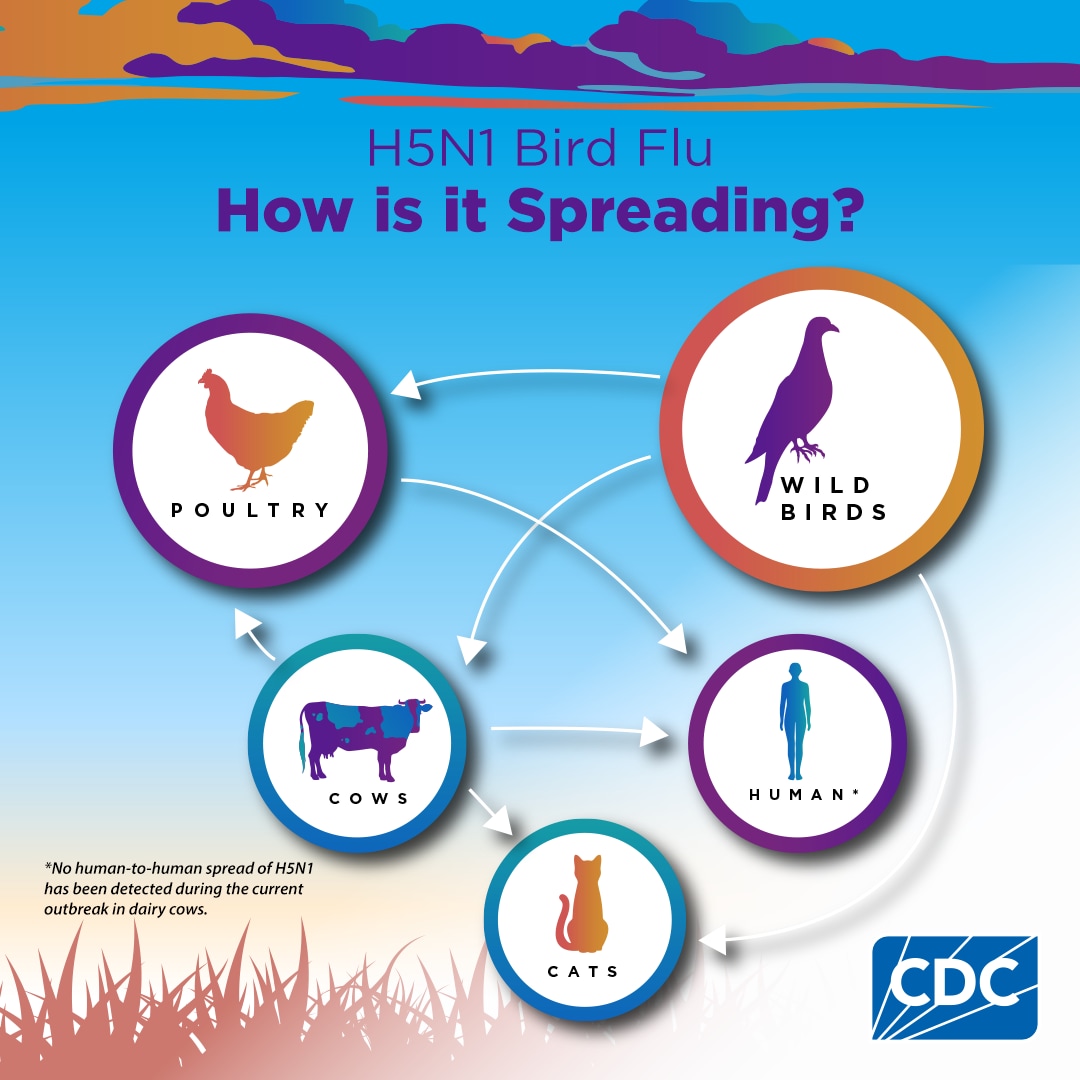
Instagram Sample Message – Spanish
¿Te estás preguntando cómo el virus #H5N1 de la influenza aviar se está propagando en vacas lecheras?
Si bien el riesgo actual de contraer el H5N1 de la influenza aviar es bajo para la mayoría de las personas, las que tienen contacto con animales infectados o posiblemente infectados están en mayor riesgo y deben tomar medidas para protegerse.
Ve el enlace en la biografía para mantenerte al día sobre la situación actual de la influenza aviar H5N1.
#SaludPública #InfluenzaAviar #H5N1
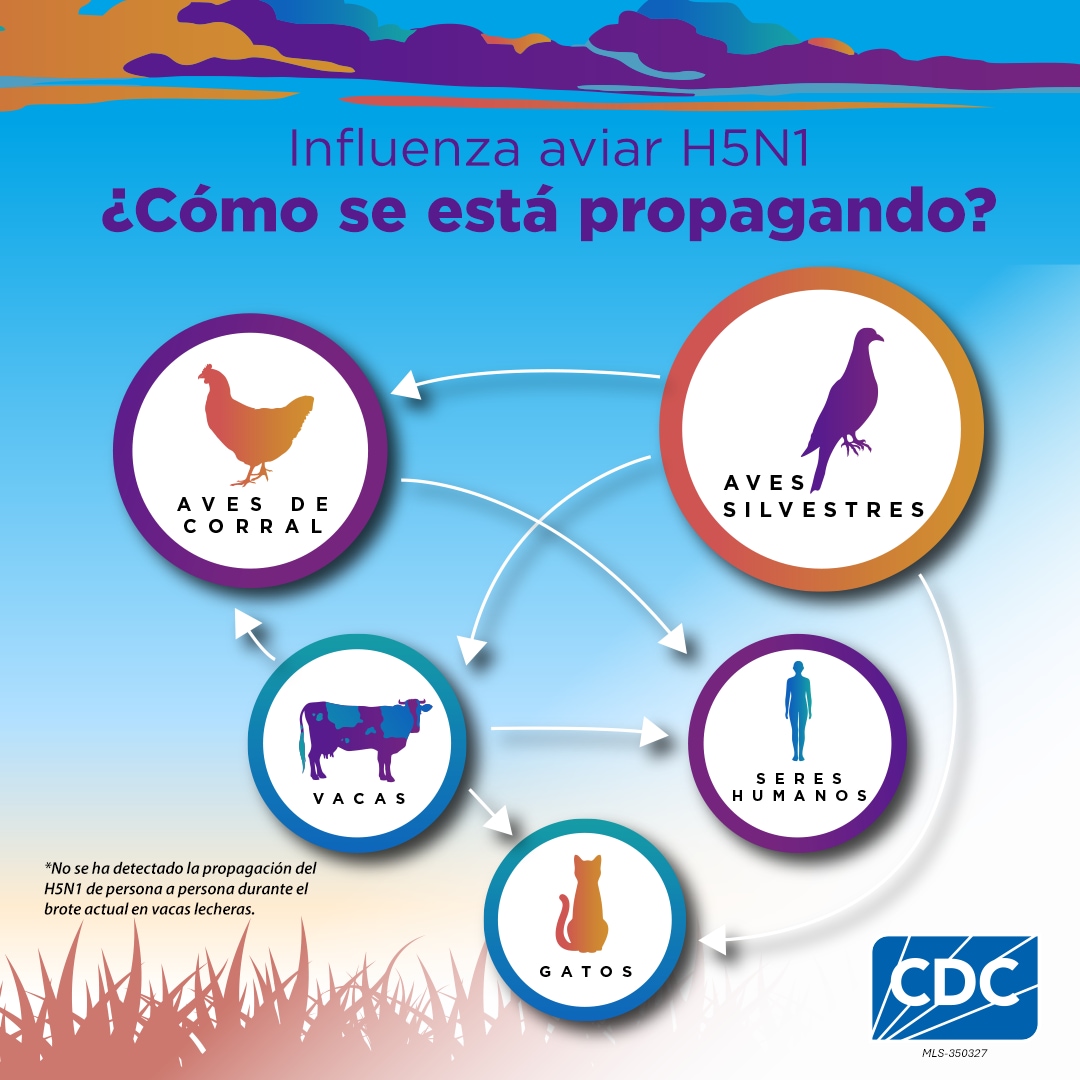
LinkedIn Sample Messages – English
Farm workers: When in contact with infected or potentially infected dairy cows, raw milk, other animals, or surfaces and other items that might be contaminated with #H5N1 bird flu virus, take action to reduce your risk of infection.
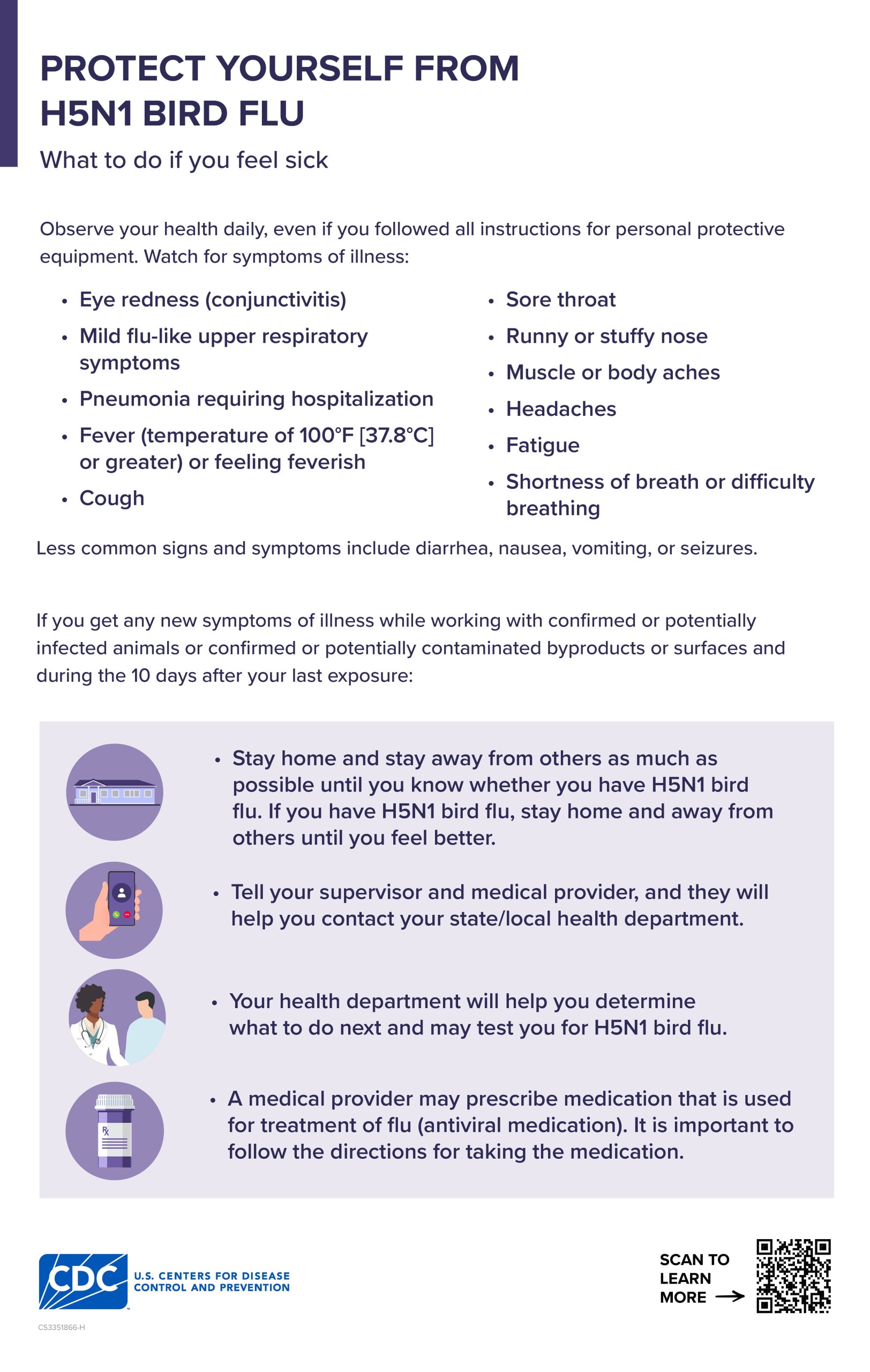
Wear personal protective equipment and learn how to put on and remove it safely.
CDC recommends farm workers monitor their health for 10 days after their most recent exposure and contact their local health department if they get symptoms.
Symptoms can include:
- Fever (Temperature of 100°F [37.8°C] or greater) or feeling feverish/chills*
- Cough
- Sore throat
- Difficulty breathing/shortness of breath
- Eye tearing, redness, or irritation
- Headaches
- Runny or stuffy nose
- Muscle or body aches
Protect yourself by following these recommendations:
https://www.cdc.gov/bird-flu/prevention/farm-workers.html
There is currently a multistate outbreak of #H5N1 bird flu in dairy cows and poultry. CDC recommends protective measures for workers who are exposed to infected or potentially infected animals.
LinkedIn Sample Messages – Spanish
Trabajadores de granja: Cuando estén en contacto con vacas lecheras, leche cruda y otros animales infectados o posiblemente infectados, o con superficies y otros objetos que podrían estar contaminados con el virus #H5N1 de la influenza aviar, tomen medidas para reducir su riesgo de infectarse.
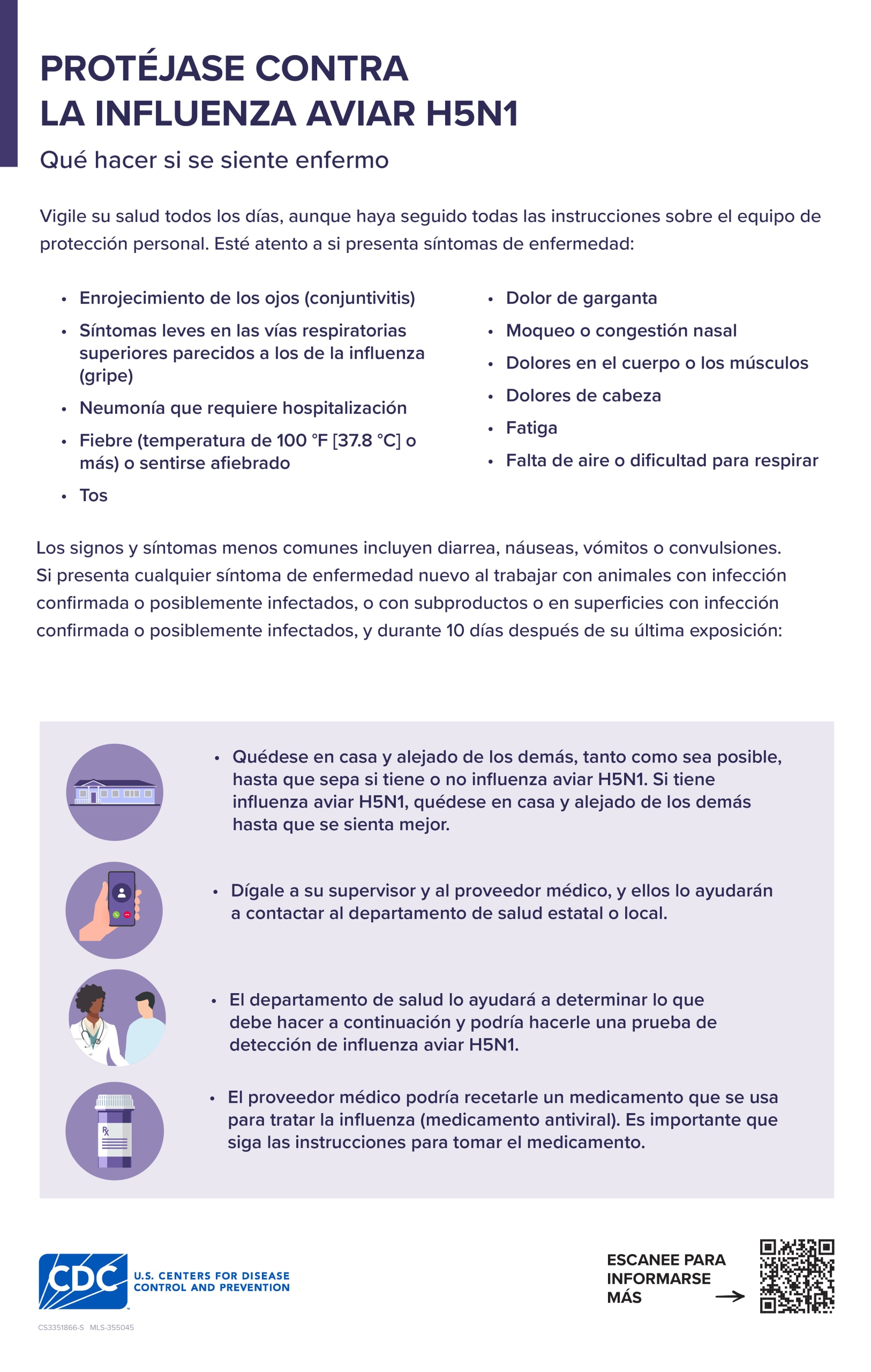
Usen equipo de protección personal y sepan cómo ponérselo y quitárselo de manera segura.
Los CDC recomiendan que los trabajadores de granja vigilen su salud durante 10 días después de su exposición más reciente y que contacten a su departamento de salud local si presentan síntomas.
Los síntomas pueden incluir:
- Fiebre (temperatura de 100 °F [37.8 °C] o mayor) o sentirse afiebrado, o tener escalofríos*
- Tos
- Dolor de garganta
- Dificultad para respirar
- Ojos llorosos, enrojecidos o irritados
- Dolor de cabeza
- Moqueo o congestión nasal
- Dolores en los músculos o el cuerpo
Actualmente, hay un brote multiestatal de influenza aviar #H5N1 en vacas lecheras y aves de corral. Los CDC recomiendan medidas de protección para trabajadores que podrían estar expuestos a animales infectados o posiblemente infectados.
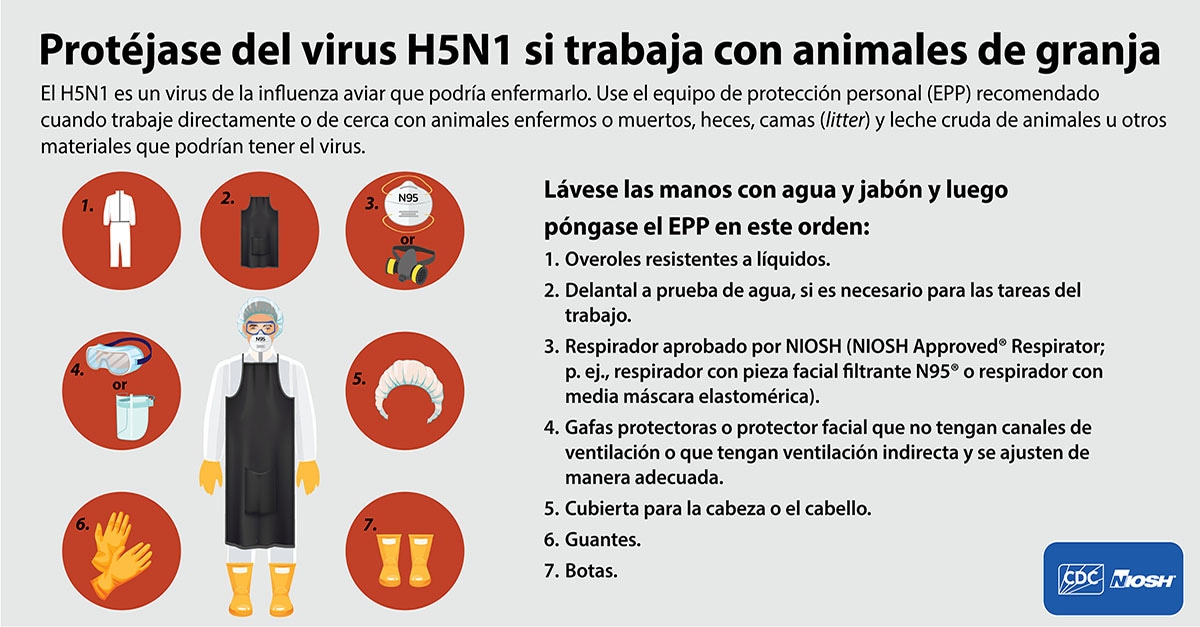
People with exposure to infected birds
Share the below prevention messages online or on social media.
Twitter Sample Messages – English
Per CDC, H5 #birdflu virus infections in US wild birds/poultry pose a low risk to the public. People very rarely get sick with bird flu, but those with work or recreational exposures to infected birds/poultry should take precautions:
https://www.cdc.gov/bird-flu/prevention/
If you work with poultry infected with H5 bird flu virus, you are at higher risk of getting sick w/ bird flu yourself. CDC recommends poultry workers take precautions, including proper use of personal protective equipment to minimize your exposure risk. https://www.cdc.gov/bird-flu/prevention/
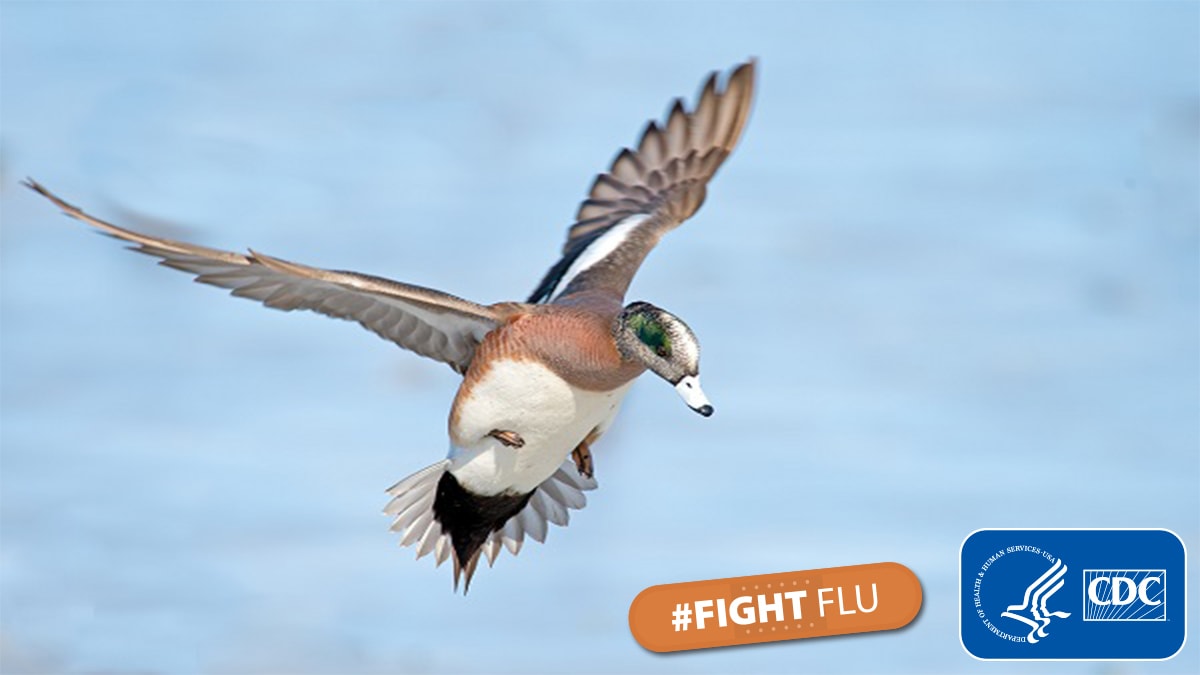
Twitter Sample Messages – Spanish
CDC: las infecciones de influenza aviar reportadas en aves de corral y silvestres en EE. UU. presentan un riesgo bajo para el público. Es raro que las personas se enfermen, pero las que tengan más exposición a aves infectadas deberían tomar precauciones:
https://espanol.cdc.gov/bird-flu/prevention/
Hay brotes actuales de influenza aviar en aves de corral y silvestres en los EE. UU. Si trabajas con aves infectadas, tienes un riesgo mayor de exposición a la influenza aviar. Los CDC recomiendan que los trabajadores avícolas tomen precauciones:
https://espanol.cdc.gov/bird-flu/prevention/
People with backyard poultry
Share the below prevention messages online or on social media.
Twitter Sample Message
#DYK there are ongoing outbreaks of H5 bird flu in US birds? If you have backyard poultry, learn how to protect them and yourself against bird flu. While human infections are rare, CDC recommends precautions for people w/ exposure to infected birds:
https://www.cdc.gov/bird-flu/prevention/
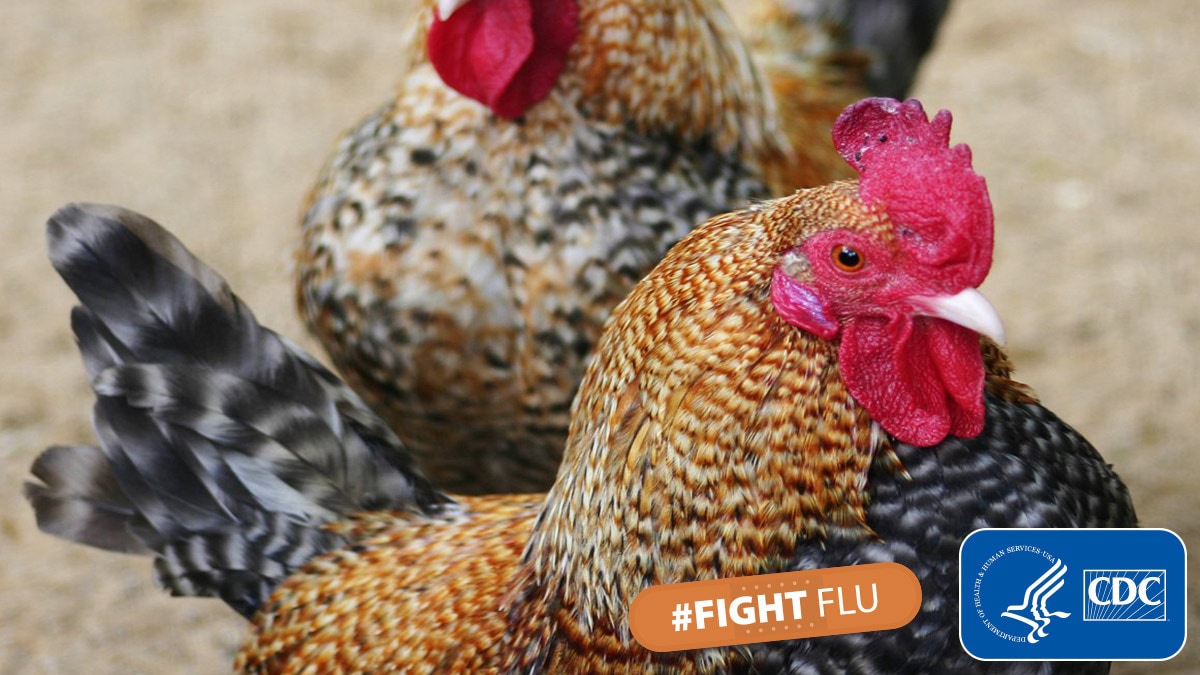
Facebook Sample Message
Did you know there are ongoing outbreaks of H5 bird flu in wild birds and poultry in the United States? CDC recommends people with exposure to infected birds take precautions to avoid bird flu virus infection, even though human infections are rare. If you have a backyard poultry flock, protect your poultry and yourself against bird flu.
Instagram Sample Message
Did you know there are ongoing outbreaks of H5 bird flu in wild birds and poultry in the United States? CDC recommends people in contact with infected birds take precautions to avoid bird flu virus infection, even though human infections are rare. If you have a backyard poultry flock, protect your poultry and yourself against bird flu.
https://www.cdc.gov/bird-flu/prevention/
#FightFlu #PublicHealth
